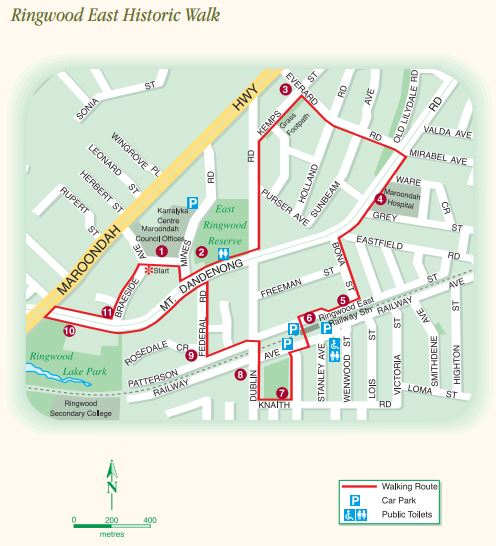Ringwood East Historic Walk (Ringwood East)

.jpg)
A 5.5 km historical walk around the Ringwood East area. The walk starts at the Maroondah Council Offices and refreshments are available at the Ringwood East shops.

Route Description:
1. Mining - Start at the entrance to the Council Offices. The first discovery of antimony at Ringwood occurred in the late 1860s and numerous mines dotted this hill and employed well over a hundred men.
2. East Ringwood Recreation Reserve - From the 1880s, this reserve has been used for picnics, gymkhanas, cycling races and athletic meets, as well as football and cricket finals. It is home to the East Ringwood Football Club (est. 1930), East Ringwood Cricket Club (est. 1926) and the East Ringwood Tennis Club.
3. Cass' School - In 1874, Edward Feehan Cass started the first school in Ringwood (now home to Lionsbrae Retirement Village). After this school closed in 1893, Ringwood State School began in Ringwood Street. The East Ringwood State School began in 1924 further east on Everard Road. It closed in the 1990s but the original classroom still remains.
4. Maroondah Hospital - Maroondah Hospital was officially opened by Sir Henry Winneke in 1976. The land was originally part of the Ware Estate, then a sports oval.
5. St Francis de Sales Catholic School - St Francis de Sales, opened in 1958 by Archbishop Simonds. The building is now part of the hospital services.
6. Railway - The Ringwood East Railway station was opened by W.H. Everard MLA in 1925.
7. Swimming Pool - One of the disused clay mines was converted into a swimming pool in the 1910/20s and was used for competitions but closed due to a number of drownings. It was eventually filled in and is now Knaith Park. The Community Hall was built in the 1950s, later joined by the 3rd East Ringwood Scouts and the Red Cross.
8. Army Reserve Depot - Numerous brick and tile works began operating in the Ringwood East area in the 1880s. It was also a source of white clay called kaolin which was used for porcelain.
The Army Reserve was formed in the late 1950s on the Ringwood Brickmaking Co. site.
9. Flower Farms - What was later known as Howship Bros Rosedale Nursery, originated in 1905 with local identity John Hill. This property put Ringwood on the map as a centre for Melbourne's trade in flowers. A dairy also operated on the east corner of Federal and Mt Dandenong Roads.
10. Club Hotel (now Daisey's, now closed down) - The original Club Hotel was built by George T. Wiggin. George was a son of Thomas Wiggin, licensee of the first Coach & Horses Hotel. Livestock was sold from a paddock on the west side of the Club Hotel in the 1880/90s. Ringwood's first hall was located on the east side of the Club Hotel; originally called the Gordon Hall (or Miner's Hall), it was also used for the overflow of students when Cass's school was full.
11. Township of Ringwood - This area was called the Township of Ringwood in the mid-1800s and supported hundreds of local workers. The general store was located at the bottom of Braeside Avenue, as well as John Curran's store (who sold mining equipment), a butcher, boot maker and others. A mounted police station was opened at 32 Mount Dandenong Road in February 1888. A modest wooden Catholic church stood on land in Whitehorse Road, as well as a United Free Methodist Church in 1887. There was also a Presbyterian Church in 1909.
Access for Dogs:
Dogs are permitted on leash.
Review:
It is quite a long walk between points of interest along residential streets (mostly with footpaths). The walk is mainly story-telling because there little to see visually that is exciting.
Location
304A Maroondah Highway, Ringwood East 3134 View Map
Web Links
→ Ringwood East Historic Walk Guide and Map (PDF)








